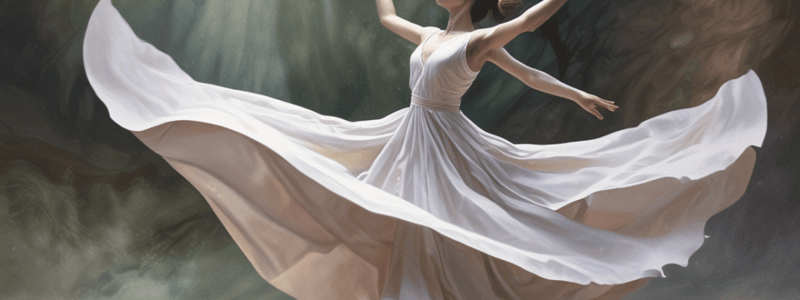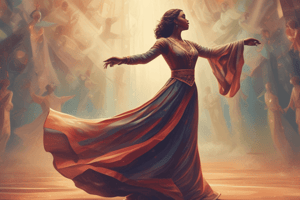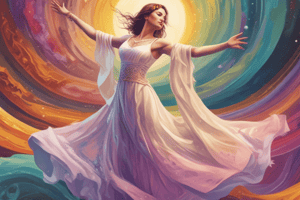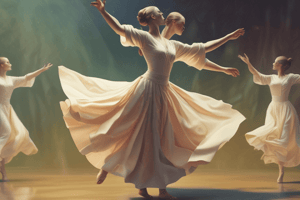Podcast
Questions and Answers
What is liturgical dance?
What is liturgical dance?
- A dance style that focuses on storytelling through movement
- A form of worship that combines artistic expression with spiritual meaning (correct)
- A form of exercise that combines physical movement with spiritual reflection
- A type of dance that is only performed in religious settings
Why is it important to study traditional movements, gestures, and symbols in liturgical dance?
Why is it important to study traditional movements, gestures, and symbols in liturgical dance?
- To understand the historical and cultural significance of these elements (correct)
- To incorporate cultural elements into a dance performance
- To create a unique and modern dance style
- To connect with a higher power and convey religious messages
What should you research before studying traditional movements, gestures, and symbols?
What should you research before studying traditional movements, gestures, and symbols?
- The history of liturgical dance
- The cultural context of your chosen faith tradition (correct)
- The biographies of famous liturgical dancers
- The choreography of famous liturgical dance performances
How can you immerse yourself in the tradition of liturgical dance?
How can you immerse yourself in the tradition of liturgical dance?
What should you take note of when observing traditional liturgical dance choreography?
What should you take note of when observing traditional liturgical dance choreography?
What is essential for creating an authentic and powerful liturgical dance performance?
What is essential for creating an authentic and powerful liturgical dance performance?
Why is it important to understand the significance of traditional movements, gestures, and symbols?
Why is it important to understand the significance of traditional movements, gestures, and symbols?
What resources can be utilized to study traditional liturgical dance?
What resources can be utilized to study traditional liturgical dance?
What is the primary purpose of liturgical dances?
What is the primary purpose of liturgical dances?
What should you do when analyzing the music for a liturgical dance?
What should you do when analyzing the music for a liturgical dance?
What should you draw inspiration from when creating movement phrases?
What should you draw inspiration from when creating movement phrases?
Why is it important to incorporate traditional steps and movements?
Why is it important to incorporate traditional steps and movements?
What can you experiment with to add complexity to your choreography?
What can you experiment with to add complexity to your choreography?
How can you emphasize the spiritual or symbolic elements in your choreography?
How can you emphasize the spiritual or symbolic elements in your choreography?
What should you do after completing the initial choreography?
What should you do after completing the initial choreography?
What is important to consider when performing your choreography?
What is important to consider when performing your choreography?
Who can provide valuable insights into the historical context and cultural significance of traditional elements in liturgical dance?
Who can provide valuable insights into the historical context and cultural significance of traditional elements in liturgical dance?
What should you do after the performance?
What should you do after the performance?
What is the key to successfully incorporating traditional music and rhythms into your choreography?
What is the key to successfully incorporating traditional music and rhythms into your choreography?
What is the first step in incorporating traditional movements and gestures into your choreography?
What is the first step in incorporating traditional movements and gestures into your choreography?
What is the key to mastering traditional movements in liturgical dance?
What is the key to mastering traditional movements in liturgical dance?
What is the significance of symbols in liturgical dance?
What is the significance of symbols in liturgical dance?
How can you incorporate traditional elements into your choreography?
How can you incorporate traditional elements into your choreography?
Why is it important to research traditional music and rhythms?
Why is it important to research traditional music and rhythms?
What is the benefit of immersing yourself in traditional music and rhythms?
What is the benefit of immersing yourself in traditional music and rhythms?
Why is it essential to study traditional movements, gestures, and symbols in liturgical dance?
Why is it essential to study traditional movements, gestures, and symbols in liturgical dance?
What is the role of expert practitioners and scholars in liturgical dance?
What is the role of expert practitioners and scholars in liturgical dance?
What is the focus of this tutorial?
What is the focus of this tutorial?
What is the primary purpose of liturgical dance?
What is the primary purpose of liturgical dance?
What is the spiritual aspect of liturgical dance derived from?
What is the spiritual aspect of liturgical dance derived from?
What is the role of symbolism in liturgical dance?
What is the role of symbolism in liturgical dance?
Why is researching traditional movements essential in liturgical dance?
Why is researching traditional movements essential in liturgical dance?
What is the ultimate goal of liturgical dance?
What is the ultimate goal of liturgical dance?
What is the result of engaging in regular practice and performance of liturgical dances?
What is the result of engaging in regular practice and performance of liturgical dances?
What is the role of costumes in liturgical dance?
What is the role of costumes in liturgical dance?
What is the importance of spirituality in liturgical dance?
What is the importance of spirituality in liturgical dance?
What is the result of incorporating symbolism into the choreography?
What is the result of incorporating symbolism into the choreography?
What is the discipline required for liturgical dance?
What is the discipline required for liturgical dance?
Flashcards are hidden until you start studying
Study Notes
Traditional Elements in Liturgical Dance Choreography
- Liturgical dance combines artistic expression with spiritual meaning, using movement and dance to convey religious messages and connect with a higher power.
- Incorporating traditional movements, gestures, and symbols into liturgical dance choreography is essential for creating an authentic and powerful performance.
Understanding the Historical and Cultural Context
- Research the traditions, rituals, and customs associated with liturgical dance within your chosen faith tradition or cultural heritage.
- Understanding the historical and cultural context provides a foundation for understanding the significance of traditional elements and how they can be applied in a modern liturgical dance context.
Immersing Yourself in the Tradition
- Attend live performances, workshops, or classes by experienced liturgical dancers who specialize in traditional choreography.
- Take note of the specific movements, gestures, and symbols used and observe how they convey meaning within the context of the performance.
Learning from Expert Practitioners
- Find and connect with expert practitioners and scholars who specialize in the study of traditional liturgical dance.
- Seek their guidance and mentorship to deepen your understanding and refine your knowledge of traditional elements.
Analyzing Movement and Gesture Vocabulary
- Study the vocabulary associated with the specific tradition or culture you are interested in.
- Pay attention to the body movements, arm positions, hand gestures, and footwork that are commonly used.
- Note the various meanings and nuances attached to different movements and gestures within the cultural and religious context.
Practicing and Internalizing the Movements
- Practice is key to mastering traditional movements in liturgical dance.
- Break down the movements and gestures into smaller components and practice them separately.
- Focus on the alignment, posture, rhythm, and flow of each movement.
Understanding Symbols and their Interpretation
- Symbols play a significant role in liturgical dance, conveying deep spiritual meanings and messages.
- Study the symbols associated with your chosen tradition or culture and learn about their interpretations within the liturgical context.
Creating Choreography with Traditional Elements
- Select a specific theme or narrative that aligns with your chosen tradition or cultural heritage.
- Use the traditional vocabulary you have learned to create movements and gestures that express the intended meaning or storyline.
- Integrate symbols thoughtfully and intentionally, ensuring they align with the overall theme and enhance the spiritual and emotional impact of the performance.
Incorporating Traditional Music and Rhythms
- Research traditional music and rhythms associated with your chosen tradition or culture.
- Understand the purpose of the dance and ensure that the movements and music align with the intended purpose.
- Analyze the music and identify the different sections, dynamics, tempo, and mood changes.
- Create movement phrases that capture the essence of the music and its cultural roots.
- Incorporate traditional steps and movements, and emphasize the spiritual or symbolic elements.
Understanding the Importance of Spirituality and Symbolism
- Liturgical dance is deeply rooted in spirituality and religious symbolism, expressing faith and connecting with a higher power through movement.
- Spirituality and symbolism contribute to the overall choreography, creating a sacred atmosphere and enabling participants to connect with their faith on a deeper level.
Enhancing the Spiritual Experience
- The ultimate goal of liturgical dance is to create a spiritual experience for both the dancers and the audience.
- The combination of spirituality and symbolism helps to create a sacred atmosphere and enables participants to connect with their faith on a deeper level.
Nurturing the Spiritual Growth of Dancers
- Liturgical dance not only creates a spiritual experience but also nurtures the spiritual growth of dancers.
- Engaging in regular practice and performance of liturgical dances deepens dancers' understanding of their faith and develops a closer relationship with God.
Studying That Suits You
Use AI to generate personalized quizzes and flashcards to suit your learning preferences.





